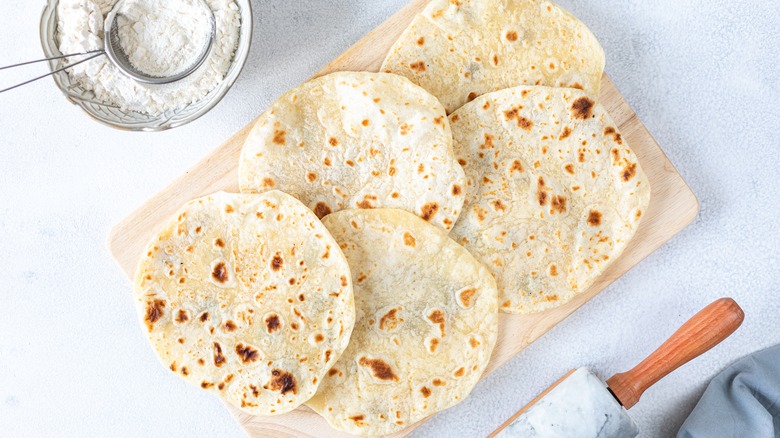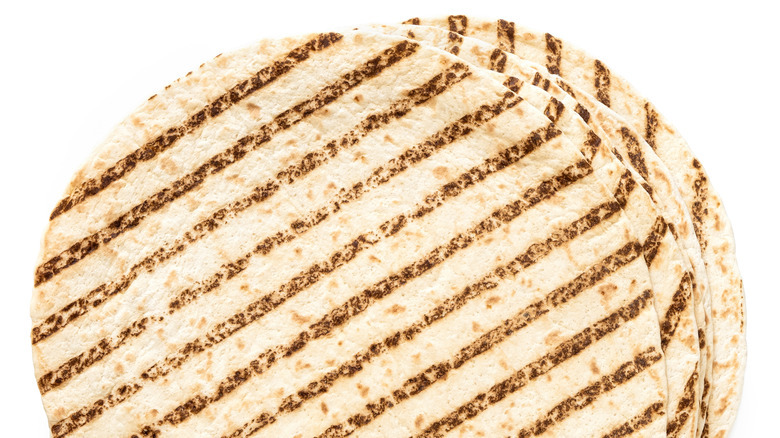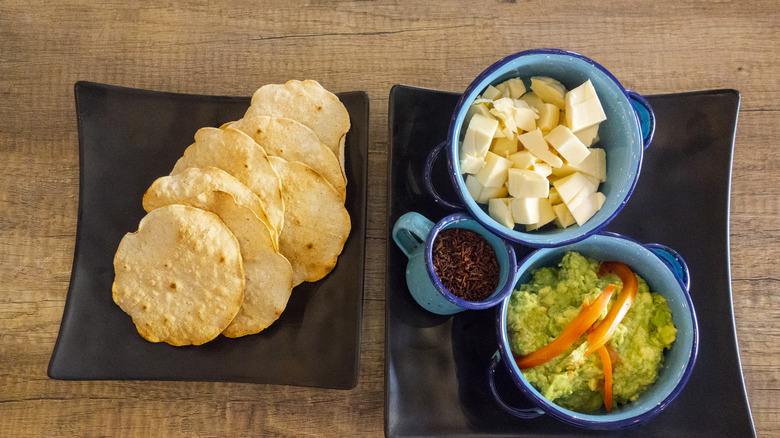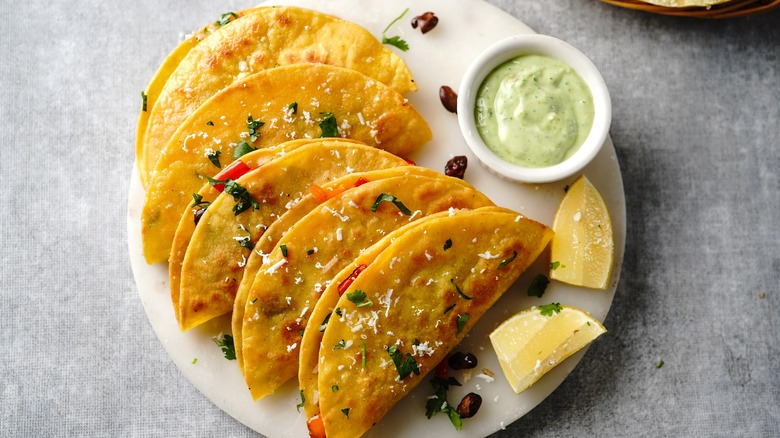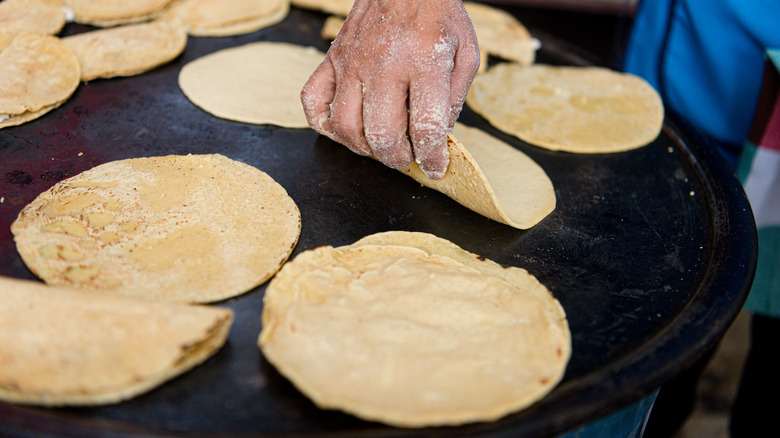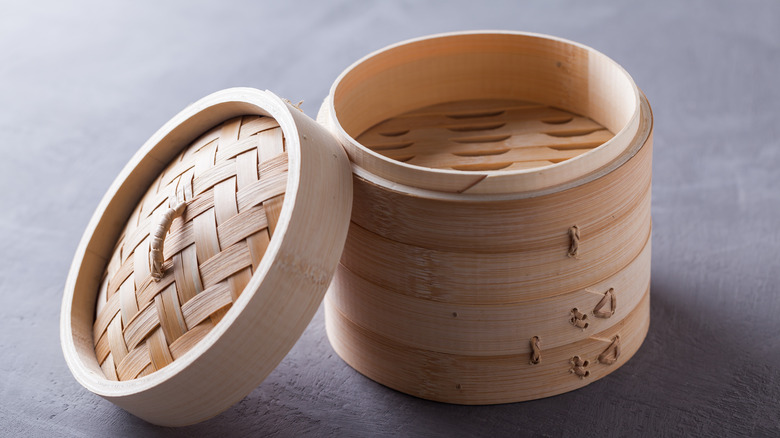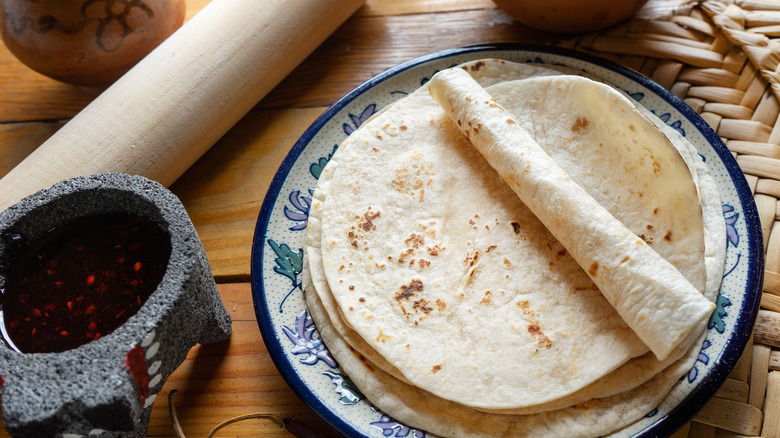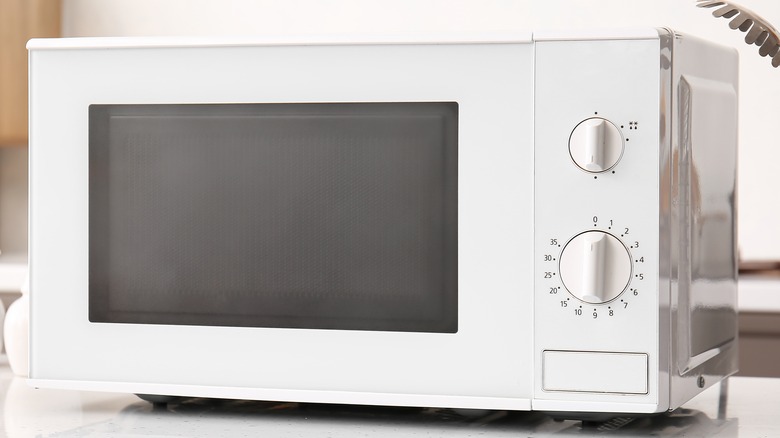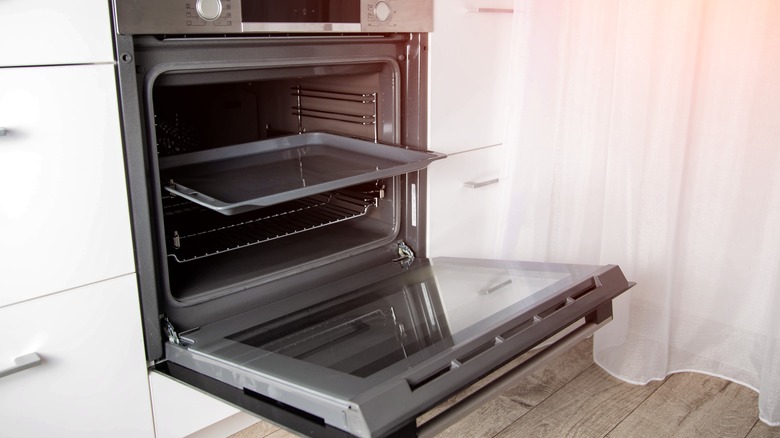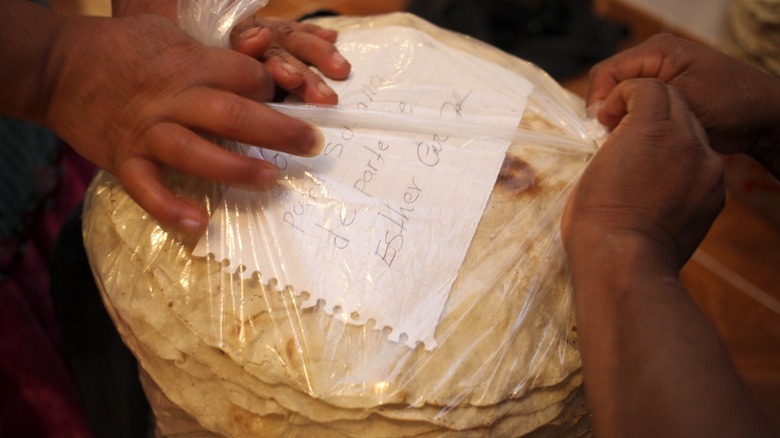10 Tips For Making Store-Bought Tortillas Taste Restaurant Quality
When making Mexican food at home, it's easy to get good results as long as you have solid recipes. However, you might have noticed a weak link in your taco or burrito nights: store-bought tortillas. As the James Beard Award-winning Mexican food expert and cookbook author Rick Martinez told Tasting Table in an exclusive interview, "Store-bought American tortillas are horrible." You could make your own tortillas to solve this problem, but that might be more work than you want to do, and not even all Mexican restaurants do this. The secret to making your store-bought tortillas taste as good as they do in restaurants is to heat them up the right way.
Warming up tortillas is mandatory because it improves their texture and flavor. There are multiple ways to achieve restaurant-quality results; which one you choose depends on how exactly you want your tortillas to taste, whether you're using corn or flour, and what dish you're trying to make. These tips will help you warm up your tortillas so they taste like they do in your favorite Mexican restaurant. You'll also learn how to buy the best tortillas and serve them in a way that preserves their quality.
1. Char them
One of the main problems with store-bought tortillas is that they have preservatives in them. As Martinez explained to us, the masa dough used to make corn tortillas is highly perishable — if left at room temperature, it begins to ferment in a matter of hours. A hefty dose of preservatives allows commercially-made corn tortillas to sit on grocery store shelves for long periods of time without spoiling. However, the preservatives also negatively affect the flavor of the tortillas. "The preservatives add a slight sourness. If you open a package of corn tortillas at the grocery store, they have this weird sour note to them like somebody put a spritz of vinegar in the bag."
One of the most effective ways to neutralize this acidic flavor is to char your tortillas slightly. Per Martinez, "The char marks will add a little bit of bitterness, which will counteract the sour flavor." This can be achieved in a number of ways. If you're already grilling ingredients for your tacos, simply throw your tortillas on the grill at the last minute. If you're cooking inside, the flame of a gas burner or a ripping-hot cast iron skillet can achieve similar results. Whatever method you choose, opt for high heat and just a few seconds of cooking; you don't want the tortillas to become crunchy, just to get a little color on the outside.
2. Toast them in the oven
Toasting corn tortillas in the oven is a great way to mask the flavor of the preservatives. Martinez suggests laying the tortillas out on a baking sheet in a single layer and baking them at 350 degrees Fahrenheit for around 15 minutes until they're golden brown and crispy. Toasting totally transforms their flavor; as he said, "they'll taste like toasted corn without any of the off-flavor."
Although you won't be able to fold these crunchy, flat tortilla disks, you can use them to make tostadas with any fillings and toppings you'd normally use for tacos. If you're looking for inspiration, our pinto bean tostada recipe is simple and packed with flavor. For something more taco-shaped, a simple trick for homemade crunchy taco shells is to drape tortillas over an oven rack and bake them — they'll crisp up into classic crunchy taco shells.
One nice thing about the oven-toasting method is that it doesn't require any oil. If you're craving tostadas or crispy tacos but want a lower-fat version (or don't want to make a mess by frying tortillas at home), oven-toasted corn tortillas are a delicious option.
3. Fry them
Of course, fried tostadas taste great too, and Martinez endorses frying tortillas as well. If you fry your tortillas in a generous amount of neutral oil, you'll get a similar crispy texture and toasted corn flavor as the baked version. Even better, the tortillas will have the indulgent craveable fattiness shared by all fried treats.
You have two options when frying tortillas. Keeping them flat and tostada-shaped is the simplest method. Just cook the tortillas one at a time, flipping once — it only takes a minute or two for them to become crunchy and slightly puffed.
You can also make your own fried taco shells, but this requires a little more skill. It starts the same way — add one tortilla at a time to a skillet with hot oil. To shape the tortillas into taco shells, use tongs to fold them in half after they've fried for a few seconds, then hold them in place with the tongs until they're fully cooked. It takes a little bit of effort, but the results will be so much better than any boxed taco shells you can buy.
4. Add water before warming
A cold, prepackaged corn tortilla is inherently going to be a little stale. After a tortilla is cooked, the starch inside it begins to recrystallize, giving it the dry, crumbly texture that's familiar to anyone who's tried to eat a tortilla straight out of the fridge.
The best way to combat this is to warm up your corn tortillas with water. This will soften the crystallized starches and give you a texture that's similar to freshly-made tortillas. We're not talking about boiling your tortillas; instead, briefly dunk them into a dish of water and then heat them up on a hot skillet, griddle, or comal. This method gives you the best of both worlds: The exterior of the tortilla will still pick up some of the brown spots and char that counteract the sour flavor of the preservatives, while the interior will remain moist and tender. Moistening the tortillas with a mixture of oil and water before heating works too — the oil will add some flavor and enhance browning.
5. Steam them to keep them moist
The dunk-and-griddle method is great for adding moisture when you only need to warm a few tortillas, but you can't heat up a large number of tortillas all at once this way. If you want to heat up tortillas in bulk using a wet cooking method, follow Rick Bayless' advice and steam them.
Steaming corn tortillas makes them feel soft and fresh, and you can fit a bunch of tortillas into a steamer basket. This method doesn't give you the browned exterior that you get from a skillet or griddle, but steaming doesn't require constant supervision like griddling does, so it's great when you're cooking for a crowd. The procedure couldn't be simpler; per Bayless, "Just bring some water to a boil, put the tortillas over your vegetable steamer, put a top on it, and just let them sit off the fire for 10 to 15 minutes" (via Food & Wine).
6. Heat flour tortillas in butter
Many of the tips in this list are geared toward corn tortillas, but this technique works best with flour tortillas. In contrast to corn tortillas, which often taste best when heated in a pan without oil, flour tortillas taste great with a little bit of fat added. And no fat adds more flavor than butter. All this method requires is a hot skillet. Heat your tortillas one at a time in a small amount of butter until they are speckled with brown spots and some air bubbles have puffed up. Each tortilla takes around 30 seconds per side.
Don't leave your tortillas in the pan for too long, as they will start to toast and fry in the butter and become crispy. This is delicious, of course, but it isn't really what you want unless you're making quesadillas. If you're not a fan of butter, you can experiment with other types of fat, too — lard or olive oil would both be delicious.
7. If you must use a microwave, wrap tortillas in plastic or a damp towel
For restaurant-quality tortillas, it's generally preferable to not use the microwave, but we understand that you may be drawn to the convenience of nuking your tortillas. When you're already making things like taco or burrito fillings, rice, and beans, you may not have the mental capacity (or stove space) for more elaborate heating methods. The good news is that there are methods for making microwaved tortillas taste a little closer to the ones you get in restaurants.
Rick Bayless' preferred microwave technique gets you an end product that's somewhat similar to steamed tortillas. He recommends moistening some paper towels, covering your stack of tortillas, and throwing them in the microwave for less than a minute. The wet paper towels should help prevent your tortillas from drying out or getting tough.
Another way to microwave tortillas while retaining moisture is to wrap a stack of up to 12 in plastic wrap and microwave for about a minute and a half, flipping partway through the heating process.
8. Heat in large batches in the oven
If you need to heat up a large party's worth of tortillas and make them taste something close to restaurant quality, the oven is the best choice. This method is different from Rick Martinez's oven-toasting technique; the goal here is to end up with steamy, soft, pliable tortillas, not browned and crunchy ones.
You have two options here. The first is to set your oven to warm and spread your tortillas over a baking sheet. They'll heat up in around 10 minutes this way. However, since they're exposed to the dry air of the oven, there is a danger that they'll dry out if you leave them in for too long. For softer tortillas, wrap them in foil and put them in a 350-degree oven until hot. The sealed aluminum foil packet will retain water and give you a tender stack of tortillas. You do need to plan ahead if you use this method and remember to start heating up your tortillas around 15 minutes before it's time to eat.
9. Use a tortilla warmer
Whatever method you've chosen to warm your tortillas, the job is only halfway done once they're hot. You know how Mexican restaurants usually deliver your tortillas to the table in a cute lidded container? That's not just a nice way to present them — it serves an important purpose for their taste and texture too. Putting the hot tortillas together in some kind of closed container lets them steam together and soften up. If you go straight from heating tortillas to eating them without this resting step, they'll never be as tender.
You don't necessarily have to buy a special tortilla warmer for this task. A towel will work fine, although it won't keep the tortillas hot for very long. If you're looking to heat up a bunch of tortillas and have them remain soft throughout the duration of a meal, a purpose-built warmer is a worthwhile (and relatively cheap) investment. The ones that are shaped like fabric pockets keep tortillas warm the longest and prevent them from going soggy, but the hard ones that are shaped like little crocks have advantages too. Some are microwave or oven-safe, allowing you to heat and hold your tortillas in one vessel.
10. Avoid buying stale tortillas
While there are many ways to heat up store-bought tortillas that make them taste more like homemade ones, none of them will work if you don't start with the freshest, highest-quality tortillas you can buy. Martinez told us he would rather eat his taco fillings on top of corn chips than try to rescue old, stale tortillas.
There are a few ways to check if the tortillas in your store are fresh. Per Martinez, "If you look at the package and they're dry or crumbly or they're all stuck together or the edges are frayed or jagged, that means they're super old and I just wouldn't buy them." He also said that droplets of condensation inside the package are a tell-tale sign that the tortillas were manufactured recently. If you're not sure after a visual inspection, pick up the bag of tortillas and try to bend it; if they feel soft and pliable, they're fresh. To increase your chances of finding fresh tortillas (and other Mexican ingredients), Martinez recommends seeking out Mexican grocery stores.
